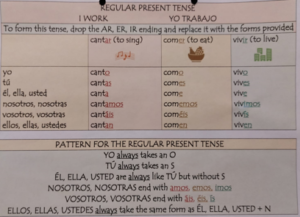![]() To start with your tenses, I suggest you to watch this video, where I explain all the aspects of the Regular Present Tense:
To start with your tenses, I suggest you to watch this video, where I explain all the aspects of the Regular Present Tense:
youtube.com/watch?v=b5tkObfogB0&t=1s
Here you have a chart which will help you to remember this tense.

Now, I will give you some examples, putting some more elements in the phrase. To do this, I will use the days of the week (lunes, martes, miércoles, jueves, viernes, sábado, domingo). Remember that we do not write capital letters for days of the week, months of the year and nationalities.
Verbs in -ar. Example: estudiar (to study)
Present tense: estudio, estudias, estudia, estudiamos, estudiáis, estudian
On Monday, I study Spanish. El lunes estudio español.
On Tuesday, you study French. El martes estudias francés.
Remember that when it is followed by a day, “on” must be translated as “el”, never “en”.
Verbs in -er. Example: comer (to eat)
Present tense: como, comes, come, comemos, coméis, comen
On Wednesday, he eats fish. El miércoles, él come pescado.
On Thursday, she doesn’t eat chicken. El jueves, ella no come pollo.
Verbs in -ir. Example: escribir
Present tense: escribo, escribes, escribe, escribimos, escribís, escriben
On Friday, we write messages. El viernes escribimos mensajes.
On Saturday, you all write letters. El sábado escribís cartas.
On Sunday, they don’t write anything. El domingo no escriben nada.
